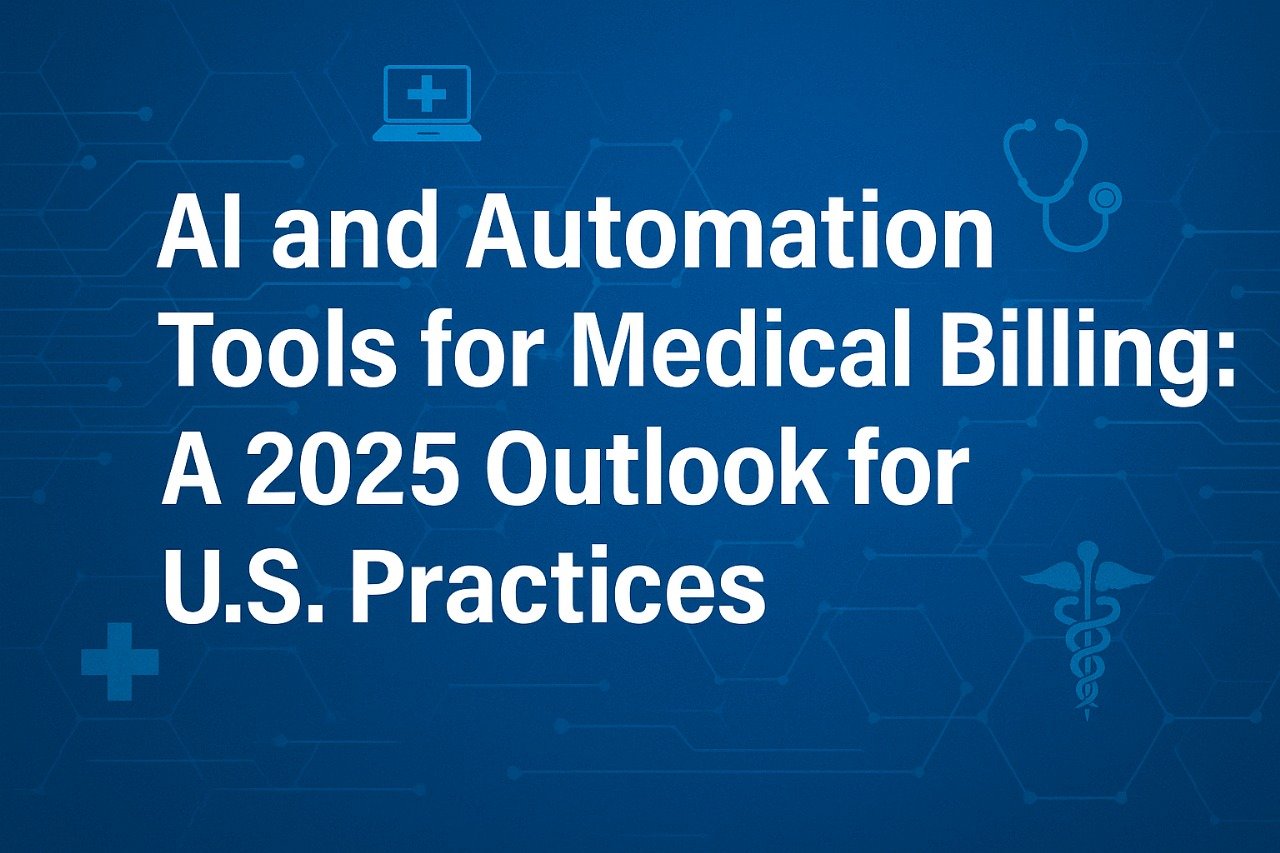
Introduction
In 2025, artificial intelligence (AI) and automation are taking centre stage in medical billing and coding—offering the potential to streamline workflows, reduce errors, and alleviate administrative burdens. Recent industry surveys reveal that AI tools have surpassed EHR usability as the top tech priority for medical practices, with roughly one-third of leaders listing it as a primary focus for the year (tebra.com, mgma.com). From coding assistants to ambient scribes and automated claim scrubbing, AI is reshaping revenue cycle management (RCM) for U.S. doctors—both in independent clinics and large health systems.
Why AI’s Role in Billing Is Growing
Medical billing requires precision: even minor documentation gaps can lead to rejected claims, delayed payments, or compliance risks. According to experts from the University of Texas at San Antonio, “if they don’t code properly, the claim can be denied or suspended, and that in turn affects the revenue cycle and profitability” (healthtechmagazine.net). Physicians, meanwhile, echo this urgency, stating AI’s greatest impact is easing administrative workloads (ama-assn.org). Key forces driving AI’s adoption include updated 2025 coding requirements (like ICD‑10‑CM/CPT changes), payer demands for accuracy, and widespread staff burnout.
Core AI Billing Tools in Use Today
1. Coding Assistants and Claim Scrubbers
AI-driven coding tools review clinical documentation, recommend CPT/ICD codes, and detect inconsistencies. Platforms can even provide real-time suggestions or flag missing info before claim submission (topflightapps.com, medwave.io). These systems improve accuracy and reduce denials, particularly for practices handling high volumes of claims.
2. Robotic Process Automation (RPA)
RPA handles routine, time-consuming tasks—like eligibility checks, claim tracking, and payment posting—without human input (medwave.io). By deploying “bots” for repetitive processes, practices can redeploy staff to value-added tasks, reducing errors and speeding up billing cycles.
3. Ambient Scribes and Voice-Based Documentation
AI-powered scribe services such as Microsoft’s Dragon Copilot, Ambience Healthcare, Abridge, and Heidi Health are increasingly integrated into clinical workflows (wsj.com). These systems record encounters, summarise conversations, and draft clinical notes while flagging billing elements—making documentation and coding both efficient and accurate. Physicians have reported reducing daily paperwork from 90 minutes to under 30 (wsj.com).
4. AI-Powered Fraud Detection & Claim Validation
Modern AI platforms analyse claim data to identify errors, unusual billing patterns, and potential fraud. These tools improve compliance and catch costly mistakes before claims are submitted .
Benefits for Medical Practices
- Enhanced claims accuracy: AI identifies missing modifiers, incorrect CPT codes, and compliance issues before submission.
- Faster billing cycles: With automation, reimbursements arrive sooner, improving cash flow.
- Reduced workload and burnout: Automating repetitive work frees coders and physicians to focus on clinical care (tebra.com, ama-assn.org, businessinsider.com).
- Smarter revenue cycle management: Integrated AI tools help track claim status and predict denials in real time, enabling proactive resolution (outsourcestrategies.com).
Challenges and Cautions
Despite clear advantages, AI in billing demands careful implementation:
- Integration hurdles: Not every EHR or PMS interfaces seamlessly with AI tools, especially for smaller or legacy systems (tebra.com).
- Data privacy and compliance: AI systems must adhere to HIPAA, SOC 2, ISO 27001, and similar standards to protect patient information (en.wikipedia.org).
- Overdependence on AI: While helpful, AI is not infallible—providers must verify coding recommendations and audit flagged claims.
- Cost of adoption: Although costs are decreasing, smaller practices must weigh ROI carefully and consider phased rollouts (ama-assn.org).
Recommendations for Doctors and Practices
- Conduct a needs assessment
Identify which billing tasks—coding, claim scrubbing, documentation—would benefit most from automation. - Choose compliant, integratable platforms
Prioritise tools that integrate with your EHR/PMS and meet rigorous data-security standards. - Start small with pilots
Deploy AI in a limited area (e.g., coding review), measure accuracy and efficiency gains, and then expand. - Train staff thoroughly
Coders, billers, and physicians should be trained to understand how AI tools work and how to verify outputs. - Monitor KPIs
Track metrics like denial rates, days in A/R, coder efficiency, and documentation time to assess impact.
Future Trends
Looking ahead, practices can expect broader AI adoption and new capabilities, such as:
- AI-guided prior authorisation automation—speeding up often cumbersome approval workflows.
- Predictive denial forecasting—letting practices anticipate and address issues before they disrupt revenue.
- Multimodal AI agents like MedOrch, capable of interfacing with various EHR tools to support complex billing and clinical scenarios (techtarget.com, medwave.io, ama-assn.org, arxiv.org).
Additionally, startups such as Ellipsis Health are raising significant funding to embed AI automation deeper into EHRs and RCM systems (wsj.com). Meanwhile, physicians increasingly view AI as vital to alleviating administrative burdens and improving patient care delivery.
Conclusion
AI and automation tools are no longer futuristic concepts—they’re here, transforming medical billing in 2025. From ambient scribes to intelligent coding assistants, these solutions yield more accurate claims, better revenue performance, and less burnout. However, successful adoption depends on smart integration, user training, and adherence to privacy standards. For practices willing to invest thoughtfully, AI offers a powerful way to optimise workflows, safeguard reimbursement, and enhance patient care.



